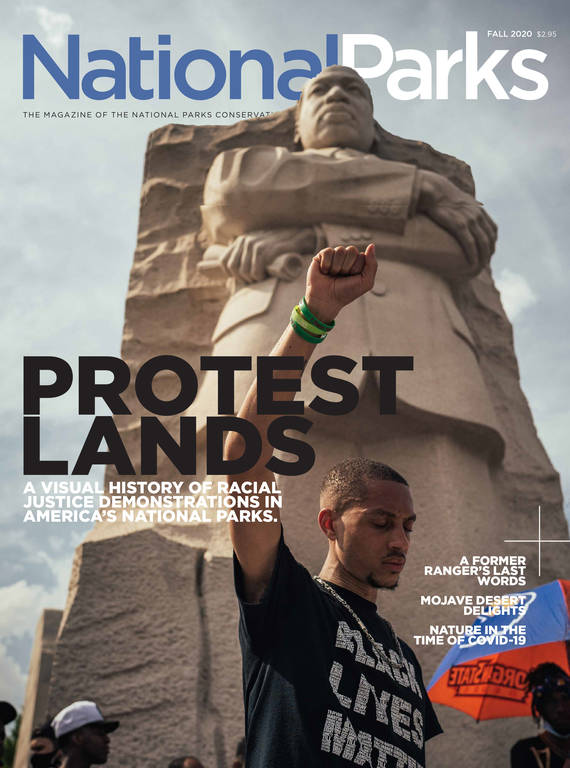Fall 2020
The DIY Desert
Grab a map, load up on water and choose your own adventure at Mojave National Preserve.
Two hours after leaving Las Vegas, we rolled to a stop at Hole-in-the-Wall Campground. It was 2:30 a.m., and my pal Liz, who had been asleep in the passenger seat even as we rattled over 40 miles of Mojave National Preserve’s dirt roads, finally roused and peered out the window into the dark night. “Are we here?” she asked.
I will be honest: At that point, I did not think the preserve was going to be that cool. Broad strokes, the big wilderness parks in California protect and honor the superlatives: Redwood National Park has the tallest trees on earth. Death Valley is the hottest, driest and lowest place on the continent. Sequoia, designated in 1890, is the state’s first national park (by about a week), and Yosemite is possibly the most legendary. Mojave National Preserve, meanwhile, didn’t even exist until 1994. Its northern boundary is, like, an hour from the Luxor Casino on the Las Vegas Strip. Greater Los Angeles is two hours west of the park. Given how easy it is to get here, why didn’t someone manage to make it a national park before, well, someone else managed to build a replica of an Egyptian pyramid on the Strip?
This was all in the back of my mind while Liz and I uncurled from the car and set up camp. No sooner had we crawled into our sleeping bags and switched off our headlamps than a shooting star streaked overhead — then another, and then another. As it turned out, we were catching the tail end of the Orionid meteor shower. I’d like to say we planned for this, but in truth this was just the first in a series of lucky strokes and good turns the desert and its residents would do us in the coming days. Liz and I stayed awake chatting for an hour, and I counted 18 shooting stars, to say nothing of the gazillion stationary ones or the vivid wash of the Milky Way reaching all the way across the sky.
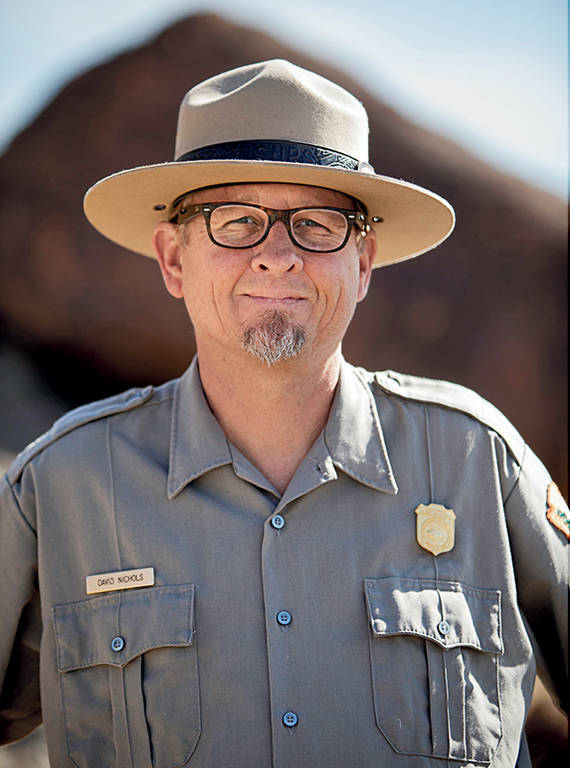
Archaeologist David Nichols has worked at the preserve since 2001. One of a few dozen people who own off-thegrid homesteads in the preserve, he helped the author find ancient rock art and historical cabins that didn’t appear in any of the guides she had consulted.
© IAN SHIVE/TANDEMSTOCK.COMIn the morning, I put myself on coffee duty while Liz scrambled some eggs. The first three water spigots I tried in the campground didn’t work. At the fourth, I pulled up on the handle and a huge spider tumbled out into my empty water bottle. So we made coffee with water from the gallon jugs we’d picked up the night before, then hurried to meet up with the preserve’s archaeologist, David Nichols.
I’d emailed Nichols the week before, hoping he’d be able to point us in the direction of some interesting stuff to see. The preserve has been his office since 2001, and he’s still adding important discoveries to his roster of archaeological finds. (The park is his backyard, too — he’s one of a few dozen people who own remote, off-the-grid homesteads within its boundaries.) “Nothing is better than asking questions while cruising through the preserve,” he had replied, offering to show us around. That was a relief, since it’s surprisingly hard to find much advice about the preserve online, and what I did turn up focused on the same handful of highlights. But the park is the size of Delaware. There had to be more to it.
We met Nichols at a trailhead near our campsite. The holes in his Park Service-issued jacket indicated routine encounters with sharp rocks or cactuses. After quick introductions, he set off down the trail, walking like someone who spends a lot of time covering rough ground on foot. Liz and I hustled to keep up as we descended into a mazelike canyon. While we navigated a sort of sketchy ladder of metal rings hammered into the rock, Nichols — whose affection for this prickly place was immediately apparent — filled us in on how and why Congress established the preserve.
It dates to the passage of the California Desert Protection Act. Signed 25 years before our visit, in October 1994, the act determined the fate of 9.6 million acres of Southern California desert, establishing 69 new wilderness areas, expanding Joshua Tree and Death Valley national monuments and “upgrading” them to national parks, and creating Mojave National Preserve.
“When Congress created the preserve, they basically drew a line around all the good stuff and said, ‘OK, the Park Service gets all this,’” Nichols said in his amiable Southern California drawl. The park’s wonders are many: red cinder cones, craggy lava flows, sand dunes that glimmer bone-white in the sun, one of the world’s largest Joshua tree forests, sculpted granite mountains, dry lake beds and a trove of rock art documenting thousands of years of human history on the land.
Nichols paused suddenly, looked around, then veered off the trail, making toward a cluster of nondescript boulders perched upslope. We followed him into the shade of a refrigerator-sized rock. “Yep, this is one of them,” he said.
When my eyes adjusted to the shadows, I saw a dizzying array of circles, squiggles and branching lines. Thick as my finger, the carvings were pale against the dark rhyolite boulder. We would eventually encounter rock art from three distinct cultures: the Mojave, the Chemehuevi and an ancient people who predated both of these groups. “This is the archaic stuff,” Nichols said. “Old. Thousands upon thousands of years.”
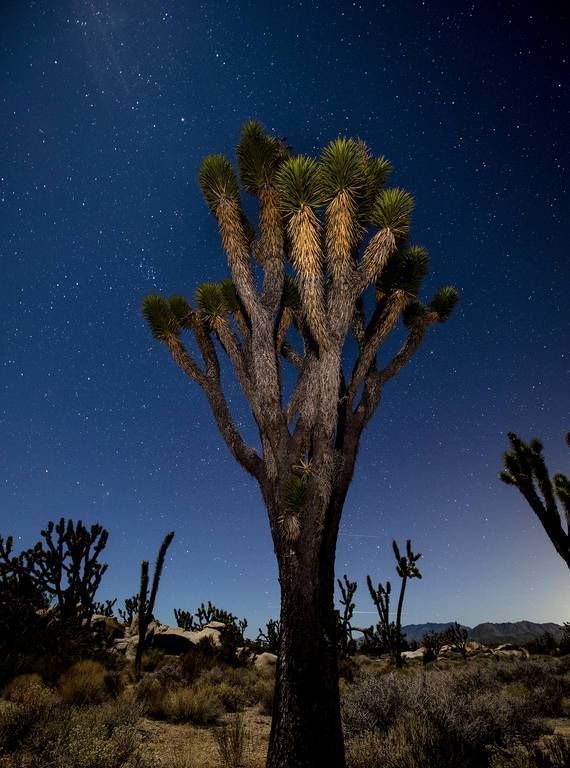
A Joshua tree in the preserve.
© IAN SHIVE/TANDEMSTOCK.COMThe going theory, Nichols said, is that this style of rock art was made by people in the throes of hallucination induced by consuming datura, a poisonous white flower that still grows in roadside ditches around the preserve. “People on datura see circles, flashes, dots and lines,” Nichols said. He pointed to the shapes wrapping around the boulder. “Like this.”
Feeling lucky to have such an expert guide, we marched on. Our trail passed more carvings — accompanied in one instance by a few sporadic scratches. “That’s graffiti. Modern people don’t go through the effort it takes to grind in an image that will last for thousands of years,” Nichols said.
Under the floodlights at the car rental lot in Vegas the day before, I’d felt like a poser climbing into the obnoxiously large Jeep I’d reserved for the trip. But it paid off: We spent the next three days putting the thing through a vehicular hell of deep sand, loose rocks and washed-out gullies, making the most of the thousand miles of dirt roads that cross the preserve. Paved roads are few and far between. The only ones we traversed were Kelbaker Road and Kelso Cima Road, twin desert highways that meet near the center of the park at Kelso, a semi-revived ghost town that was once the heart of a Union Pacific Railroad outpost.
Our second day out, we stopped by the Kelso Depot, a stately Mission Revival building that now houses a visitor center and gift shop. (It’s also one of the few places in the preserve where you can fill up your water jugs, which — after the spider-bottle incident — Liz and I got a little fanatical about doing at every opportunity.) We ambled through the exhibits, admiring black-and-white photos of the depot in its heyday and in the depths of its abandonment, before the Park Service brought it back to life in 2005.
NPCA AT WORK
Our water supply duly topped up, we headed off to see a remnant of long-ago volcanoes that bubbled up in the heart of the park. The cave — actually a lava tube, the hardened shell of an ancient underground eruption — is not easy to find, even though it is one of the park’s star attractions. The turnoff from the highway is unmarked, and no signs tell you which path is the right one to follow through the ensuing maze of dirt roads. If we hadn’t been trailing Nichols’ truck, we might still be searching for the place.
The Park Service’s scant presence in the preserve was a mathematical reality at first: Back in 1994, the chair of the House Ways and Means Committee registered his distaste for the California Desert Protection Act by appropriating a first-year operating budget of $1 for the park. But over time, this hands-off approach became part of the management philosophy.
“Early on, it was decided to make this a park people could discover for themselves,” Debra Hughson, longtime chief of resources at the preserve, told me when we spoke. “We’re not going to put up exhibits all over the place and put a trail here and a trail here and a trail there.”
Eventually, we followed Nichols to the toe of a chunky black lava field, where the gravelly desert floor gave way to a cluster of symmetrical cinder cones. Lack of road signs notwithstanding, in the age of Instagram, some of the preserve’s more photogenic attractions seem to be gaining prominence. We arrived a couple of minutes after a group of about 50 boisterous college geologists on a field trip. Nichols looked pained at the sight of the crowd — evidently a rare phenomenon at the preserve — so we drove off to check out some nearby petroglyphs. When we came back, we had the place to ourselves.
From the parking spot, we followed a faint trail through the cinder to a ladder leading down into a gaping pit. Then it was an army-crawl through a low tunnel, trying not to crack our heads on the ceiling in the near-pitch dark. Eventually, Liz straightened up ahead of me and said, “Whoa.”
The tunnel opened into a vaulted room as long as a city bus and twice as high. A few shafts of sunlight blazed in at odd angles through holes in the roof, illuminating clouds of dust we had kicked up from the sandy floor. For a few minutes before another group crawled into the cave, we took turns twirling our fingers through the rays of light, seeing how we could make the dust billow and swirl in our wake.
The California Desert Protection Act hinged on compromise. “The Mojave National Preserve is absolutely worthy of national park status,” said NPCA’s David Lamfrom, who oversaw the California Desert program until 2019. “But if the environmentalists had insisted on designating it as a park, that would have meant no more ranching and no more hunting.” To secure the broad support the bill needed to pass, conservationists settled for preserve status, which allows a broader range of uses. Hunters have long come to the Mojave in pursuit of deer, birds and bighorn sheep. And though most grazing leases were retired in the early 2000s, one working ranch remains.
Rob Blair is the fourth generation of his family to run cattle in the Mojave Desert. To put it mildly, his is not an easy job. In wetter parts of the West, a cow can find all the grass it needs on a few acres. But the Mojave is so arid that each of Blair’s animals needs hundreds of acres of open range, and the terrain is so rugged and spiky that even all-terrain vehicles aren’t much use. The only practical way to cover ground is on horseback.
Evidently, all those years in the saddle have left Blair with time to think, and he’s used some of it to make himself into a bona fide cowboy poet. Another lucky break: Our visit coincided with the park’s 25th anniversary celebration, which was held in a dusty lot behind the Kelso Depot, steps away from a busy train track. While a food truck dished out barbecue sandwiches, staff and dignitaries reflected on how the desert had changed since the Park Service came to town in 1994. The afternoon’s festivities opened with Blair reciting a few poems.
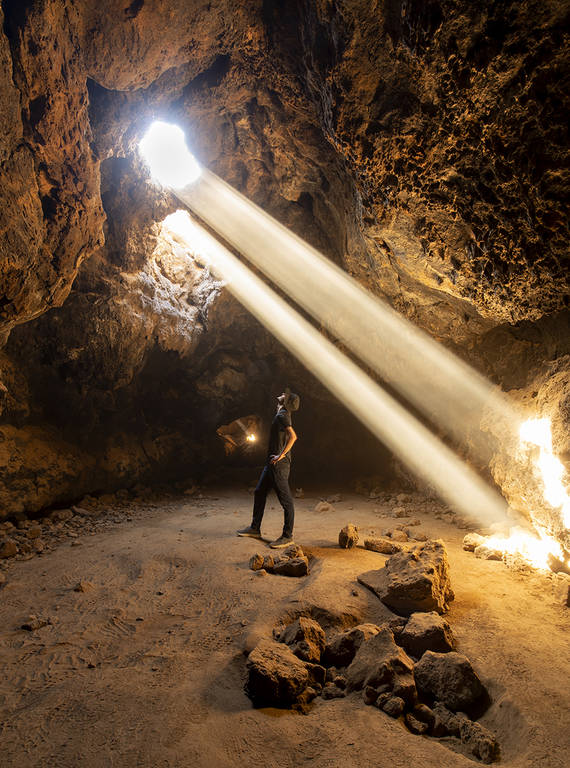
Light rays pass into a subterranean lava tube.
© IAN SHIVE/TANDEMSTOCK.COMHe took the stage sporting, I kid you not, a ten-gallon hat, a crisp Western shirt, a bowtie, a white mustache, stiff jeans and stiffer-looking boots. On just about anyone else, this ensemble would have been a get-up, but Blair made it look genuinely dignified. Raising his voice to be heard over the freight train rolling past the depot, he introduced himself: “My wife and I raised our family in a house my great-grandad was living in in 1919, just the other side of the Providence Mountains here. So, we’ve put down some roots.” He took a breath, looked off into the distance, and began with a modified version of Robert W. Service’s “The Spell of the Yukon”:
Well there’s a land, have you seen it?
It’s the cussedest land that I know.
From the Providence Mountains that screen it, to the Clipper Valley below.
And some say God was tired when he made it, and some say it’s a fine land to shun.
And maybe there’s some that wouldn’t trade it for no life on earth, and I’m one …
By some measures, Americans’ appreciation for the desert was slow to blossom. Yosemite Valley was first set aside as a park in the 1860s. Death Valley and Joshua Tree weren’t protected for another 70 years or so, and big machines were still digging open-pit mines in land that would become Mojave National Preserve decades after that. When it finally came to pass in 1994, the California Desert Protection Act affirmed what now seems obvious — that the desert is sparse, but not empty. It is fragile but resilient. Plants and animals survive on thinner margins here than almost anywhere else in the country. Scars on the land can take millennia to heal, but with rigorous protections in place, eventually they will.
The question remains: What to do with the hundreds of abandoned structures — a century’s worth of mines, homesteads, ranches and railroads — that still dot the park? Should the Park Service knock them all down, haul truckloads of rusted metal and cracked rubber off to the dump, try for a clean slate? Or are these remnants now just as much a part of this place as the Joshua trees, deserving the same care and protection?
The debate has simmered here for the past 25 years, and the conclusions vary from site to site, person to person, budget cycle to budget cycle. The Park Service has razed some buildings, restored others and blocked up many of the mine shafts so people don’t fall in. The rest of the structures are still out there, awaiting rediscovery and cranking up the intriguing character of this place.
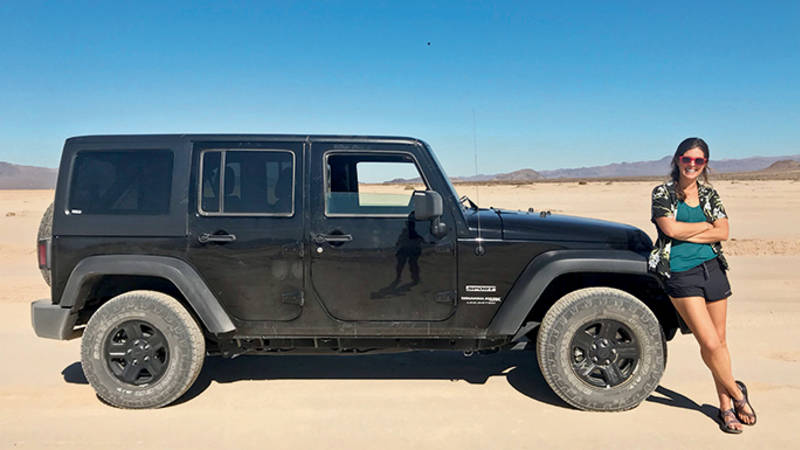
The author and her rented jeep.
©LIZ ALSPACHSunset on our last night in the desert found Liz and me high on a mountainside overlooking a Joshua tree forest, sitting on a porch swing made out of an old steel bed frame, drinking the last of the beers we’d brought with us. At our backs, an American flag flapped lazily over a 90-year-old cabin with fresh tar paper walls.
That afternoon, we’d been complaining to Nichols about the wind. Late October is generally a great time to be in the Mojave — it’s after the perilous summer heat and before the snow arrives. We had enjoyed clear skies and warm days, but every evening, the wind had come up at sunset and blown hard all night long, shaking our tent and making it tough to get much sleep.
“You should stay in one of our historical cabins tonight,” Nichols had replied. “We’ve fixed up a handful of them so they’re pretty comfortable, and if no one else has gotten there first, the place is yours for the night.” As much as I’d enjoyed my all-night meteor vigil, Liz and I were both ready for a good night’s sleep. So we followed Nichols down a rough road that climbed into a range of lumpy granite peaks somewhere north of Kelso.
TRAVEL ESSENTIALS
We parked behind the cabin, and Nichols showed us inside. I was surprised to find the door unlocked, thinking of the beefy padlocks I’d seen on old buildings in other national parks I’d visited. “We’ve found that if we don’t lock these old cabins, people don’t shoot at them,” Nichols explained. “Instead, they’ll want to come in and check the place out.”
Inside, the three rooms were tidy and spacious. Skillets hung from hooks above the sink, and a bouquet of silk flowers, a logbook and a photo album rested on a table by the door. A 50-gallon drum had found a second life as a handmade woodstove, with firewood stacked neatly beside it. Nichols pointed out a few spots where his team had made repairs, shoring up the walls and patching the rodent holes. “This was a historic preservation project, so in everything we did, we were careful to match the original structure,” Nichols said. “But everything else in here — the furniture, the dishes, the firewood — that’s all been brought in by volunteers. There’s a core group of amateur historians and preservationists that keeps a real close eye on these old cabins and does a lot of work to maintain them.” Nichols eventually headed back toward his own Mojave homestead, leaving Liz and me to take in the 100-mile views from the cabin’s front yard.
After sunset, when the wind came up and the high desert air turned chilly, we latched the cabin door and got the woodstove burning. We cooked dinner by the light of a kerosene lantern and played a few hands of cards with a well-used deck we found on a shelf.
The Park Service might not lock the structures in their care, but they don’t exactly broadcast them either. The homestead wasn’t labeled on any map that I saw, and its existence barely registers online, which may be attributable to the plea posted on the wall not to divulge its whereabouts on social media. Earlier, I’d asked Hughson how a regular person could ever hope to understand the rich history of Mojave National Preserve. “You can learn a little bit about it in the visitor center,” she allowed. “But say you see an old cabin on the hill and want to know, what’s the story behind that? You have to do your own digging. That, or you’ll leave with a sense of emptiness and vastness, and a lot of open questions.”

National Parks
You can read this and other stories about history, nature, culture, art, conservation, travel, science and more in National Parks magazine. Your tax-deductible membership donation of $25 or more entitles…
See more ›All over the park, we saw how this ethos has evolved into a point of pride for people who care for and about this place — and how it leaves space for them to share their love in arresting ways that feel closer to the truth than anything I’ve seen in a curated exhibit or a carefully worded plaque.
The cabin’s walls were a collage of faded photographs, handwritten notes, instructions and recollections from the mining family who built this cabin and lived in it throughout the 20th century. Before we stoked the fire and rolled out our sleeping bags on the worn floorboards in front of the stove, we flipped through the logbook, reading aloud entries from a cast of characters who had discovered the cabin and others who have always known it was here. “Being able to get away from the nightmare that is casino work and have this place so close is a gift,” someone had scrawled a few days before us. “Once again, a perfect night in the preserve.”
Eds. Note: As the magazine was going to press, a fire was tearing through Mojave National Preserve, burning tens of thousands of acres. Our hearts go out to the preserve and the community.
About the author
-
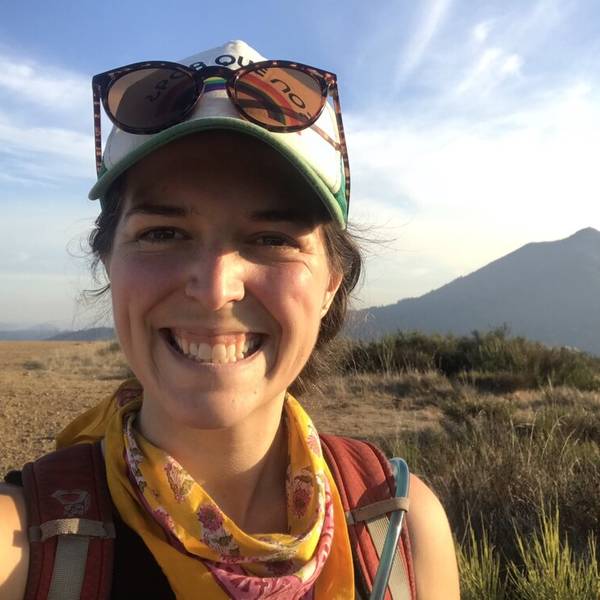 Julia Busiek Author
Julia Busiek AuthorJulia Busiek is a writer living in Oakland. She's worked in national parks in Washington, Hawaii, Colorado and California.
